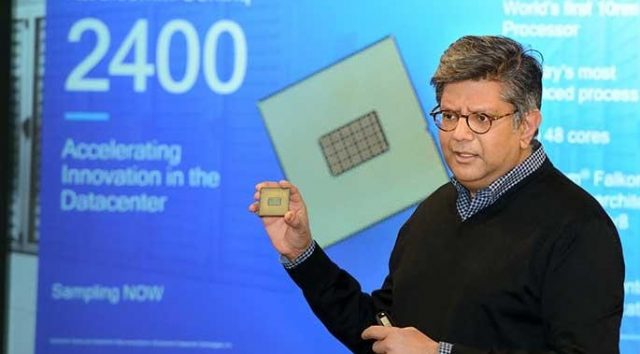Intel and its x86 processor architecture have long been the dominant duo in backend computing infrastructure, such as datacenters. But on the mobile side, ARM chip architecture has always ruled the roost. Many efforts have been mounted to try and bring ARM into the server space, but none of these project have succeeded so far.
Microsoft recently partnered with Qualcomm in an attempt to revive those efforts using Qualcomm Centriq 2400, a second-generation server chip with 48 cores and built on the latest 10nm manufacturing process.
Not stopping with Qualcomm, Microsoft also penned a deal with Cavium to use the latter’s ARM chips for testing in datacenters.
The Microsoft-Qualcomm deal is obviously the bigger of the two, and was announced at the Open Compute Summit on Wednesday. Per the agreement, Qualcomm will release a specification for ARM server chips that is based on Project Olympus, Microsoft’s open source data center hardware design program.
ARM architecture is essentially more power-efficient than x86 architecture, but even though datacenter giants like Google and Amazon – and even Microsoft – have tried to port ARM server technology into their datacenters, no major breakthrough has yet been made.
Hopefully, that will change, and the ARM ecosystem itself is “getting ready for primetime,” according to Qualcomm’s senior vice president and general manager for the company’s datacenter business, Anand Chandrasekher, who adds:
“Our relationship with Microsoft is strategic in nature. It doesn’t stop with 10nm chips. We’re working with them on doing other cool things on future projects.”
Of course, this is not the first time Microsoft and Qualcomm will be working together. Earlier this year Microsoft announced a partnership with Qualcomm to bring the full Windows 10 experience to mobile devices with the Snapdragon 835, calling them “Cellular PCs.”
The new partnership around ARM server hardware is merely an extension of their relationship, a sign that ARM has come of age and is ready to enter the datacenter space in a significant way.
One of the significant “fallouts” of this relationship, of course, is a weakening of the dependency between Microsoft and Intel. These two companies dominate the desktop PC space with their combination of software and hardware.
That relationship will live on for the foreseeable future, mind you, but the benefits of having ARM technology in a datacenter environment are just too many to ignore. Besides, if Microsoft is serious about ARM, then Qualcomm is the natural choice of partners.
But Intel has Xeon, a server CPU processor family that the company says “combines large memory capacities with leading performance, reliability, and virtualization capabilities to keep your data center supplying business advantage without interruption.”
Intel also said in a statement:
“We operate in a highly competitive market and take all competitors seriously. We are confident that Xeon processors will continue to deliver the highest performance and lowest total cost of ownership for our cloud customers. However, we understand the desire of our customers to evaluate other product offerings.”
That appears to be an acknowledgement of other players in the datacenter processor space, especially companies like NVIDIA and, now, perhaps Qualcomm as well.
We don’t yet know how successful the Microsoft-Qualcomm partnership will be, whether they’ll be successful where others have failed and so on. But it’s clear that this is the direction Microsoft wants to take for now.
The rise of compute-intensive applications and intense virtualization, along with the demand for hyperscale servers, makes it critical for cloud service providers like Microsoft, IBM, Google and Amazon to find efficiencies wherever they can, while boosting performance and scalability.
For Qualcomm, this represents a major shift from the mature mobile chipset market to an adjacent market, and it needs Microsoft as much as Microsoft needs ARM. But it’s going to be several months, at least, before we can call this the perfect partnership.
Thanks for reading our work! We invite you to check out our Essentials of Cloud Computing page, which covers the basics of cloud computing, its components, various deployment models, historical, current and forecast data for the cloud computing industry, and even a glossary of cloud computing terms.



